Hi.
Welcome to my blog. I document my adventures in travel, style, and food. Hope you have a nice stay!
Welcome to my blog. I document my adventures in travel, style, and food. Hope you have a nice stay!
Lighting has become something that's easy to take for granted until a bulb goes out. When that time comes, the number of choices available is higher than it's ever been. When shopping for light bulbs, you can sidestep the bans and continue using incandescent bulbs, despite their limited lifespan, so that you don't have to give up the familiar glow you’re used to. Some have taken the first step to using energy-efficient lighting use compact fluorescent light (CFL) bulbs.
Compared to incandescent bulbs, CFL bulbs seemed like a great upgrade. However, the reduced power consumption and heat output came with two drawbacks. Many compact fluorescent light bulbs don't achieve full brightness immediately or work well with dimmers. This has made it difficult for some to replace their incandescent lights until they could upgrade without these compromises; this is where LED lighting comes into play. When compared to incandescent and CFL bulbs, LEDs generate the same amount of light while using a fraction of the energy. LED bulbs turn on instantly to full brightness and last far longer.
Buying the right LED bulb is more than just adding one to your cart or picking one up off of a shelf. Below is a picture of an LED light bulb, the LED Lighting Facts for it, and the packaging. Each number is associated with different aspects you need to consider as you look for an LED bulb:
1 – Shape
2 – Base type
3 – Brightness
4 – Color Temperature
5 – Features
This guide helps break down the complexities around LED lighting so you can not only feel good about your purchase, but you won't have to return it later.
One of the most important things to know if you're looking to buy a LED light bulb is the shape. When it comes to light bulbs, bulb shape designations have two parts made up of letters and a number. The letters describe the bulb type while the number is an indication of the actual size where a higher number represents a larger bulb size. These numbers are used to reflect the diameter of the bulb in multiples of 1/8th of an inch. LED bulbs can be broken down into four primary categories of shapes: A-shape, reflector, decorative, and specialty.
A-Shape
A-shape LED bulbs are the most common shape available and are commonly referred to as standard shape LED bulbs. An A19 bulb has a maximum diameter of 2 3/8th inches (19/8 = 2 3/8). This shape is commonly used for LED bulbs that replace incandescent bulbs up to 75 Watts. LED replacements for 100 Watts or higher typically have an A21 shape. You may also find some LED bulbs which use the smaller A15 shape.
Reflector
These bulbs are most commonly referred to as flood or spot light bulbs due to their reflective coating, which is used to create a wide or narrow beam angle. Reflector LED bulbs have the letter R in their bulb shape designation. You'll find the most common types listed below:
|
Type |
Image |
|
MR (Mirrored Reflector) Designed to focus lighting into a single focal point, MR bulbs are commonly used in track lighting, recessed lighting, and landscape lighting to replace halogen bulbs. |
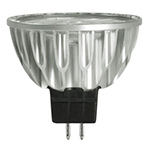 |
|
R (Reflector) and BR (Bulged Reflector) Both R and BR bulbs are directional, focusing light outward. R bulbs have a mirror-like coating inside the housing. BR bulbs are similar but have an additional mirror in the neck, creating a “bulge” just before the socket base. These bulbs are used in recessed and track lighting, and are a popular choice for wall washing or grazing. |
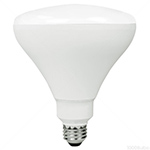 |
|
PAR (Parabolic Aluminized Reflector) PAR lamps have a flat lens and are available in several shapes including, PAR16, PAR20, PAR30, PAR36, and PAR38. These lamps are suitable for a wide variety of applications including track lighting, recessed lighting, and outdoor flood lighting. |
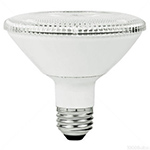 |
|
AR (Aluminum-facetted Reflector) Replacing halogen bulbs, AR lamps are generally used for low voltage applications from 12 to 24 Volts, but may also come in 120V options. These bulbs are used for retail displays and architectural lighting. |
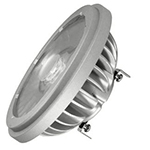 |
LED Decorative Bulbs
Smaller than A-shaped bulbs, LED decorative bulbs are commonly found in wall sconces, chandeliers, and other decorative fixtures. These bulbs are designed to add to the look of your décor and provide ambient light.
Chandelier
Featuring a shape similar to a candle, chandelier bulbs are a popular choice for a wide range of decorative lighting. Chandelier bulbs are available in these shapes:
|
Shape |
Image |
|
B (Bullet) Also referred to as Torpedo bulbs. |
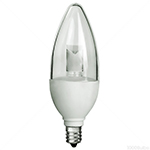 |
|
C (Candle or Conical) Conical bulbs are most commonly used for night lights and Christmas replacement bulbs. |
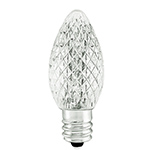 |
|
CA (Candle Angular) Designed to mimic the look of a flame, CA decorative bulbs are often referred to as Flame Tip (F) or Bent Tip bulbs. |
 |
|
LED Filament Available in both bullet and candle angular shapes, these bulbs use LED filaments to mimic the look of antique lighting. |
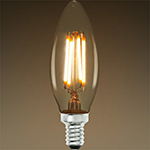 |
Globe
LED globes have a spherical design that is easy to recognize. These bulbs range in size from a 1.5-inch diameter up to a 5-inch diameter. Aside from vanity lights, LED globes are commonly used in wall sconces, light stringers, and other decorative fixtures. If you desire a more vintage look, choose LED globes with LED filaments.
LED Filament Bulbs
LED filament bulbs produce a warm glow while giving your fixture a classic look. To recreate the look of incandescent vintage lighting, the LED diodes of these bulbs are designed into a thin bar. The LED filaments last far longer than traditional filaments, but cannot fully replicate the look of wire filaments. If you desire that delicate look, choose traditional vintage bulbs instead. Aside from the chandelier and globes mentioned earlier, LED filament bulbs are available in these popular shapes:
|
Shape |
Image |
|
Edison Reproductions of Thomas Edison’s first light bulb, these popular LED bulbs are used in pendants, wall sconces, and lamps. |
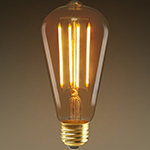 |
|
Victorian Popular for lamps, sconces, and other decorative fixtures, Victorian bulbs have an A-lamp shape. |
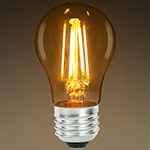 |
|
S14 Vintage S14 bulbs have vertical or horizontal filaments, and are typically used for patio string lights. |
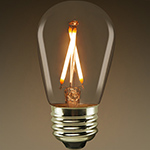 |
|
LED Silver Bowl Featuring a chrome finish on the top half of the bulbs, LED silver bowl bulbs reduce glare by redirecting light back into the fixture. These bulbs are popular picks for pendant lights. |
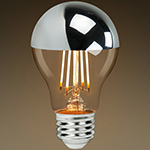 |
|
Tubular Available in varying lengths, these LED reproductions of radio tubes are used in ceiling fans, sconces, pendants, and steampunk lighting. |
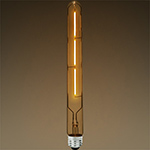 |
|
Oversized These large bulbs are ideal for pendants and other fixtures where the bulb is clearly visible. |
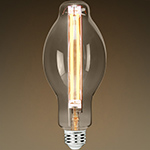 |
Specialty LEDs
These bulbs contain several less popular shapes since they are only used for limited specific applications. The bulb shapes below reflect the most searched for in this group:
|
Shape |
Image |
|
S (Straight-Sided) S-shaped bulbs can be found in clear, frosted, or colored finishes and are commonly used in signs and patio light stringer. LED filament bulbs are also available. |
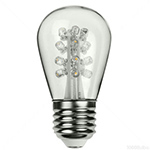 |
|
T (Tubular) Commonly referred to as miniature indicator bulbs, these bulbs are used to replace small halogen lights in automotive, instrument, or landscape lighting. |
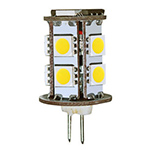 |
While this doesn't cover every single LED bulb shape out there it covers a large majority of what's available.
Once you know the shape of the LED bulb you're looking to replace the next area of focus is identifying the base because buying a bulb with the wrong base will mean that it won't fit in the lamp or fixture. LED light bulb bases fall into three main categories: Edison, bi-pin, and bayonet.
Edison
Edison base LED bulbs are the most popular, especially when looking to replace household light bulbs. The different Edison bases are labelled with an E followed by a number that indicates the width of the base in millimeters:
E12 = Candelabra base
E14 = Small Edison Screw base
E17 = Intermediate base
E26 = Medium base
E39 = Mogul base
Bi-Pin
Bi-pin bases are denoted with a “G” followed by a number which indicates the width of the space between the pins. Some of the most popular bi-pin bases are GU5.3 and GU10 which are found with MR16 LED bulbs. The GU5.3 bi-pin base just plugs into the socket while GU10s, as well as GU24 base LED bulbs, twist and lock into place. There are also instances when there are letters following the number to indicate how many pins the bulbs has. “S” stands for single-pin, “D” stands for double-pin, “T” for triple, and “Q” for quadruple.
Bayonet
Bayonet base LED bulbs have notches on the side of the base which are used to lock the bulb into place. There are generally two different kinds of bayonet base bulbs, single contact (SC) or double contact (DC), which denotes if there are one or two contact points on the end of the bulb for electrical connectivity.
With traditional incandescent light bulbs, it was simple to make sure you were getting the right light bulb. If a 60-Watt bulb is the one that broke or stopped working, you'd just get another 60 Watt and call it a day. When it comes to LED lighting, it's very different. Since LED light bulbs don't use as much power that incandescent bulbs do, they are described in terms of incandescent equivalence; you may see an LED bulb described as a 60-Watt equivalent when it only uses 9.5 Watts. This is because LEDs are measured by Lumens (the total amount of visible light put out by a light bulb). There is not a direct mathematical comparison between the Lumen ratings used in LEDs and the wattage consumed by an incandescent. To fix this, a comparison of the average Lumen output of a standard wattage bulb is given to determine the wattage equivalence of an LED light bulb.
The chart above tells you how many Lumens you need to replace your incandescent light bulb according to the Department of Energy. When looking at LED bulbs, wattage rating isn't consistent across different bulb manufacturers. For example, some brands sell 60-Watt equivalent LED light bulbs that use 11 Watts; others only use 9 Watts while both will provide a similar Lumen output. If you're upgrading to LED from an incandescent bulb, you'll notice that an LED bulb of equivalent wattage will appear bright due to incandescent bulbs decreasing in Lumen output over time.
When you walk into a room and notice that it seems really warm or that it feels more like a hospital, you're experiencing a difference in color temperature or light appearance. Lower values like the standard incandescent 2700K produce a more yellow light, while higher values like 5000K create a bluer light. Most LED bulbs are available between 2700K and 5000K.
Matching the right color temperature to the right room will make it easier to enjoy your time while in them. Here are some color temperature recommendations broken by down by room type. Check out our additional coverage on color temperature for more information.
|
|
Soft White / Warm White (2700K – 3000K) Recommended for use in:
|
|
|
Cool White (3500K – 4500K) Recommended for use in:
|
|
|
Daylight / Full Spectrum (5000K – 6500K) Recommended for use in:
|
There are some aspects of buying a light bulb that you have to know in order to make sure that you buy the right one, aspects of the bulb might vary from one light bulb to another, even if they look the same. All of this information can be found on product pages online or on the bulb box if you are shopping in a store.
Dimming
Most people are used to only turning light bulbs on and off, but some people enjoy being able take a bright room and tone it down to set the right mood and vice versa. The problem is that not all LED light bulbs are dimmable and even those that are dimmable won’t work with every dimmer. Realizing this, manufacturers provide a list of dimmers that they’ve tested to ensure compatibility. If you have older dimmers in your home or office, there’s a good chance you’ll have to look through a few different brands of LEDs to find one that’s compatible with your dimmers if you aren’t looking to upgrade them. Pairing an LED and an incompatible dimmer can lead to performance issues. Since not everyone needs the ability to dim, so you can save money by buying LED bulbs that don’t dim.
CRI
Color Rendering Index (CRI) is a scale from 0 to 100 that measures the ability of a light bulb to reproduce colors compared to noon sunlight. Incandescent bulbs are rated at 100 and many LED bulbs are usually rated somewhere between 80 and 85. This means that if you were to swap an incandescent for an LED bulb the colors wouldn’t look as good, but the savings outweigh this trade off in most circumstances. However, if color accuracy is important to you, look for LED bulbs with a CRI of 90 or above. In most settings, including museums, the difference between a 100 CRI and 90 CRI is not noticeable by most people.
Safety and Enclosed Fixture Ratings
All bulbs will have ratings that tell you what kind of conditions the bulb can be used in:
Dry location: the bulb should not be used in areas where moisture or water is present.
Damp location: the bulb can be used in areas where moisture is present in the air, such as bathrooms.
Wet location: the bulb can come into direct contact with water, but not submerged.
Enclosed Rated: the bulb is safe to use in a fully enclosed fixture such as a porch light or ceiling fixture. If used in an enclosed fixture, non-enclosed rated bulbs may overheat and have a shortened lifespan.
Dry location bulbs that are enclosed fixture rated can be used in outdoor lighting, such as landscape fixtures because the fixture protects the bulb from moisture. Unless the bulb is damp location rated, it cannot be used in open-face outdoor lighting, such eve downlights.
Life Hours
No one knows when a light bulb will stop working, but manufacturers do provide an estimate for how long it should work. For LED bulbs, that rating is decided based on how long it will take to stop producing 70% of its lumen output. Many LED bulbs are rated for 15,000 – 25,000 hours. Some bulbs on the market will last as long as 50,000 hours. These differences could account for years of use from an LED light bulb, so it’s good to know what this number is since a lower number of life hours could explain why one bulb is priced differently than another.
Energy Star and JA8
Some LED bulbs may also have efficiency certifications. Managed by the EPA and Department of Energy (DOE), LED bulbs can be submitted voluntarily by manufacturers to test the efficiency. Bulbs that meet Energy Star standards by producing a long lasting light that remains consistent over time, reduces energy costs and may qualify for state or local rebates.
Another certification to look for is JA8. A 2017 update to Title 24 regulations, JA8 certified lighting is required in the state of California for new construction, renovations, and additions to residential and commercial buildings. LED bulbs meeting these strict certifications have a longer life span, are dimmable, and have a high CRI. Like Energy Star certified bulbs, JA8 lamps may qualify for rebates. Keep in mind that states tend to follow California’s energy regulations within a few years, so your state may require these bulbs soon.
Do you have some tips or pointers for finding the right LED bulb? Share them in a comment below or on our Facebook, Twitter, LinkedIn, or Pinterest pages.
Original post by 1000Bulbs.com Staff. Additional content added by Angela Rogers. Most recent update on 3/25/2019.